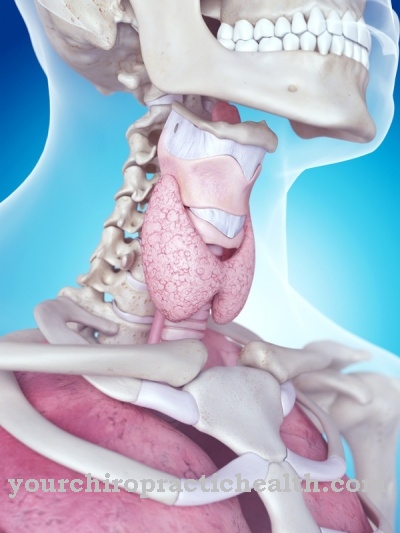The Thyroid scintigraphy belongs to the examination methods of nuclear medicine. In this procedure, the thyroid gland is imaged through a gamma camera using a radioactive agent. The aim of thyroid scintigraphy is to check the functionality of the organ, to examine the structure of the tissue and, if necessary, to differentiate between hot and cold nodes.
What is Thyroid Scintigraphy?

Thyroid scintigraphy is a nuclear medicine examination because it uses a radioactive substance to image the thyroid. In addition to palpation, ultrasound (sonography) and any necessary tissue sample (fine needle puncture), it is one of the classic thyroid examinations. The substance used in scintigraphy to visualize the thyroid gland and its physiological processes is called a tracer.
In most cases the chemical element technetium is used, with certain questions iodine can also be used. Due to the accumulation of the radionuclide in the thyroid cells, the gamma radiation is recorded by the corresponding camera and converted into two or three-dimensional images. The resulting image is called a scintigram. A special form of thyroid scintigraphy is the so-called suppression scintigraphy, in which the normal hormone metabolism of the thyroid gland is imbalanced with medication in order to search for certain clinical pictures. When it comes to assessing whether a thyroid nodule is benign or malignant, MIBI scintigraphy can also be used to supplement classic diagnostics.
Function, effect & goals
The main area of application of thyroid scintigraphy is the clarification of nodules - especially if they exceed a size of 1 cm. Scintigraphy can be used to determine whether a lump is hot or cold.
This is important because cold nodules have a low risk of malignancy, while hot nodules rarely conceal a carcinoma. The term cold or hot lump comes from the fact that the radionuclide behaves like iodine, which the thyroid needs for its hormone metabolism. More storage indicates an increased function and appears in the scintigram as a red area ("hot"), while an area that does not save appears blue and thus "cold". The uptake of the tracer in the thyroid is called uptake.
In order to make this storage in the thyroid visible with the gamma camera, a waiting time of around 20 minutes to around five minutes is observed after the tracer has been administered into the vein so that the substance can accumulate well in the thyroid. Thyroid scintigraphy is also used as standard if a previous blood test has shown overactive (hyperthyroidism). Here, the nuclear medicine examination is used to search for an autonomy of the thyroid gland. In these cases, an area of the organ has isolated itself in order to independently produce - and often too many - thyroid hormones.
These so-called autonomous adenomas can be represented as individual nodes, but can also be diffusely distributed over the entire thyroid gland. Suppression scintigraphy is particularly suitable for confirming the diagnosis of autonomy. The preparation in which thyroid hormones are taken ensures that normally working thyroid areas no longer absorb tracer due to the saturation: the autonomous area then appears very clearly. The diagnosis of so-called Hashimoto's thyroiditis can also be confirmed by thyroid scintigraphy: In this inflammatory autoimmune disease of the thyroid, the tissue is destroyed, which can also be made visible in the scintigram.
Thyroid diseases are often already visible through the typical goiter (goiter). Sometimes the tissue also grows behind the breastbone (retrosternal goiter) or is located at a distance from the thyroid gland. These special forms can also be discovered using thyroid scintigraphy.In addition, the proven nuclear medicine procedure is also suitable as a therapy control, for example after an operation or radioiodine therapy, but also during drug treatment.
Risks, side effects & dangers
Due to the use of a radioactive tracer, thyroid scintigraphy is frightened of radiation in many patients. Nevertheless, it is a very low-risk diagnostic procedure because - even in comparison to other nuclear medicine examinations - only a small amount of the tracer has to be used in order to achieve meaningful imaging of the thyroid gland. The radiation exposure is well below the value one is exposed to in one year from natural radiation on earth.
The half-life of the radionuclide is also very short at six hours. However, the contraindication of thyroid scintigraphy is when it is carried out in pregnant women. Breastfeeding mothers must not breastfeed for 48 hours after the examination. As a precaution, it is also recommended that you do not have close contact with pregnant women or young children on the day of the scintigraphy. There should be an interval of at least three months between two scintigraphies. The mostly used technetium is usually tolerated by the patient without any problems.
It cannot be compared with the contrast medium used, for example, for computed tomography (CT), so that allergic reactions are not to be feared. In order to ensure that the tracer can be absorbed by the thyroid gland undisturbed, the patient must not have ingested excessive iodine before the scintigraphy. For example, no CT must have been performed up to about two months before the thyroid scintigraphy, because the iodine-containing contrast agent could falsify the scintigraphy result. In consultation with the doctor, various thyroid medications must also be discontinued a certain period before the examination.













.jpg)

.jpg)
.jpg)











.jpg)